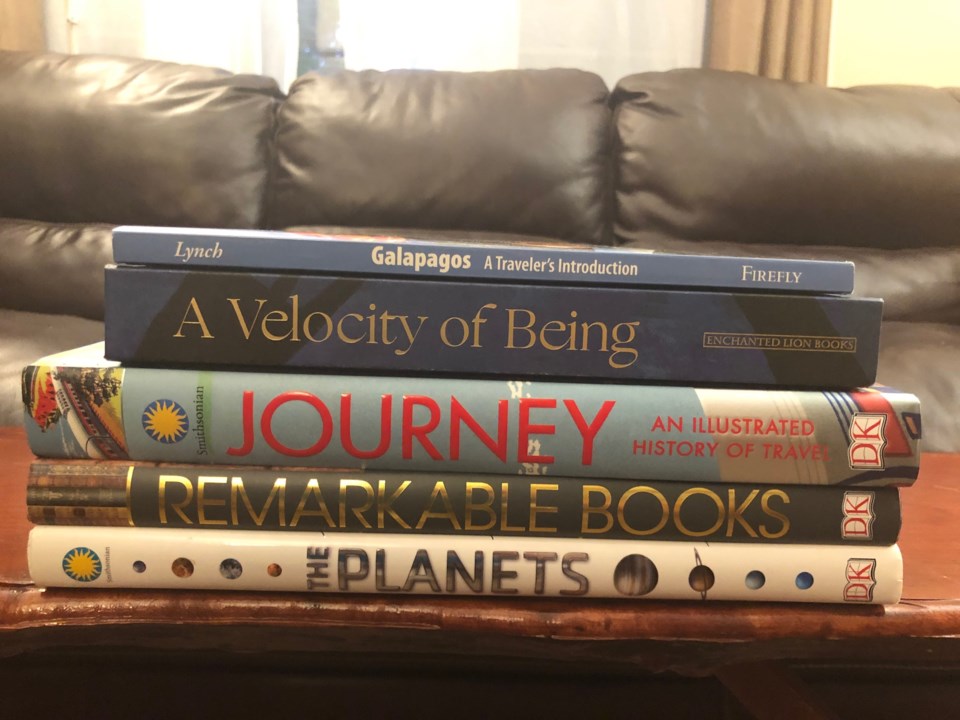Do you have one of those houses where books are displayed just perfectly on your coffee table? Lisa Day doesn’t either … but if you did, these will work
a day ago By: Lisa Day
Do you have one of those houses where books are displayed just perfectly on your coffee table, waiting for a person to pick it up and glance through it, reading an interesting fact or touching letter before putting it back just so?
Me neither. But I have beautiful coffee table books that grace my bookshelves, calling me to pull them down and flip through them, learning about Remarkable Books and travel through the ages.
Here are five coffee table books you can display just so or wherever is good for you:
A Velocity of Being, Letters to a Young Reader (Raincoast Books, www.raincoast.com)
Edited by Maria Popova and Claudia Bedrick, A Velocity of Being is a beautiful book that sat on my nightstand for a long time before being moved into a more central location in hopes more people would pluck it from the shelves and read letters written by people to young readers.
In the introduction, Popova writes that she and her fellow co-editor wanted to ensure that people understood the value of the written word and they did that by creating A Velocity of Being, demonstrating “as plainly yet passionately as possible that a life of reading is a richer, nobler, larger, more shimmering life.”
Eight years in the making, the co-editors reached out to people they admired and asked them to write a letter to a young reader about “how reading sculpted their character and their destiny.” Each letter is illustrated.
Letters include those by Judy Blume, Holland Taylor (illustrated by one of my favourites, Oliver Jeffers), Ursula K. Le Guin, Neil Gaiman and Jane Goodall, among others.
In a letter by Helen Fagin, she talks about how during captivity in a Second World War ghetto in Poland, she began teaching children math and Latin. She soon realized those subjects “were cheating them of something far more essential – what they needed wasn’t dry information but hope, the kind that comes from being transported into a dream-world of possibility.”
Fagin herself had gotten her hands on a copy of Gone With the Wind and began telling that story to her students. While most of her children were murdered during the Holocaust, Fagin was able to meet one girl years later. The woman introduced Fagin to her husband as “the source of my hopes and my dreams in a time of total deprivation and dehumanization”
Fagin goes on to write: “There are times when dreams sustain us more than facts. To read a book and surrender to a story is to keep our very humanity alive.”
Galapagos, A Traveler’s Introduction (Firefly Books, https://www.fireflybooks.com/ )
The Galapagos has been my dream vacation for more years than I care to admit; I haven’t travelled to this beautiful part of the world yet, other than through this book, which only cemented the fact I NEED to go there sooner rather than later.
The book is glorious, featuring large pictures of the amazing creatures and plant life that call these islands home as well as information about how the Galapagos. There is a section titled HIPPO, which summarizes all that we are doing to destroy this wonder of the world, and what we are doing to help.
Each time I look at this book, my desire to the Galapagos increases. One day.
This book is by Wayne Lynch.
Smithsonian Journey, An Illustrated History of Travel (DK Books, https://www.dk.com/ca/ )
From the Age of Empires to the Golden Age of Travel and The Age of Flight, this book takes you on an illustrated journey from The Ancient World to the present including the jet age and flight to the moon.
There is so much information in this DK book, but it is presented in snippets and chunks so you can read as much or as little as you want. In The Age of Steam (1800-1900) for example, we learn that Murray’s Handbooks, launched in 1836, set the template for modern-day guidebooks.
“Murray’s Guide-Books now covers nearly the whole continent. Since Napoleon, no man’s empire has been so wide.” George Stillman Hillard in Six Months in Italy, 1853.
There are also lots of pictures and illustrations – old advertisements, postcards and even photographs.
As we can’t journey anywhere at present, we might as well do it through a book.
Smithsonian The Planets, The Definitive Guide to our Solar System (DK Books, https://www.dk.com/ca/ )
Space fascinates me. I don’t know a lot about it, but I do spend a fair amount of time starring upwards. In this DK Book, space lovers can learn more about the planets in our solar system through bits of information, amazing photos, satellite images and illustrations, including a look at the internal structure of these giants and information about different parts of them.
For example on Venus, currently visible with the naked eye, “The Diana Chasm gorge is four times as long as the Grand Canyon and contains perhaps the deepest point on the planet where temperatures soar to 930 F.” Mind blowing. There is additional information for places were we have been including the “story of the moon” and various missions.
Remarkable Books, The World’s Most Beautiful and Historic Works (DK Books, https://www.dk.com/ca/)
It probably doesn’t come as a surprise, but I like books. Books make me happy. Books about books – even better.
In this book, the reader discovers information about 80 of the world’s “celebrated and historically important written words” from 3000 BC to 1900 and onward.
We learn about each significant book and get an up-close look at the outside and various pages within it. offering various pictures of the book, its pages and other important illustrations. I also like how DK presents the scale of the book – an illustration of a hand placed close to the book so you have an idea of its size.
We read about The Domesday Book, The Blue Qur’an (glorious. I have no idea what it says but it’s a stunning looking book; gold on dyed vellum, and the Cosmographia, “the first visual guide to the known world to be published in the German language.” It was printed with woodcut illustrations and created in the 16th century.
So many beautiful books that we get to enjoy and learn about thanks to this book.
Lisa Day is the author of two book blogs – Book Time (https://booktime584.wordpress.com/), where she reviews a variety of books for a variety of readers and offers author Q&As and followsummer.com, book reviews that inspire armchair travel.

